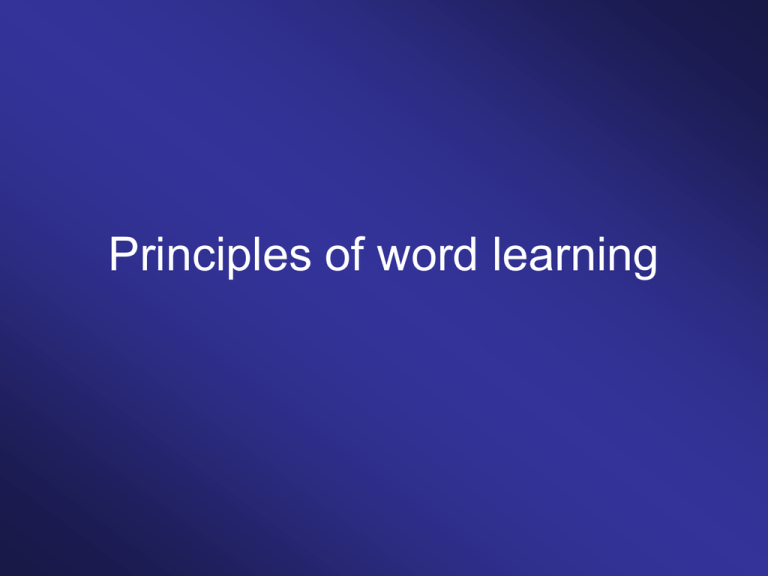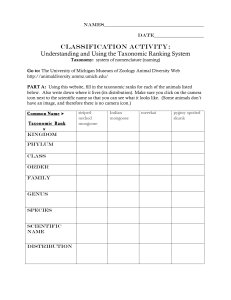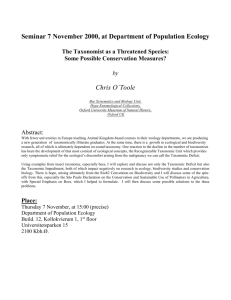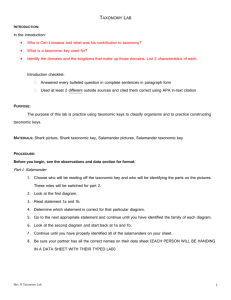History of the English Language
advertisement

Principles of word learning Constraints on word learning Gavagai Quine 1960 Constraints on word learning Gavagai: • Dog • Poodle • Bone • Barking • Blue fur • Isn‘t that a lovely day? Constraints on word learning • The whole object constraint • The mutual exclusivity constraint • The taxonomic constraint The whole object constraint New words are likely to refer to the whole object rather than ist parts, substance etc. The mutual exclusivity constraint An entity cannot have more than one name. The principle of contrast [Clark 1997] Don't take the red tray, take the chromium tray. Carey 1978 Familiar Object Novel Noun (for part) Fish Dorsal fan Fire truck Boom Hammer Claw Camera Focusing grip Telephone Receiver Race car Air foil Markman 1996 Familiar Object Novel Noun (for part) Unfamiliar Object Novel Noun (for part) Fish Dorsal fan Current detector Detector Fire truck Boom Pipe tool Damper Hammer Claw Ritual implement Crescent Camera Focusing grip Pagoda Finial Telephone Receiver Microscope Platform Race car Air foil Lung Trachea Markman 1996 Show me the boom. Prediction: Since children know the word fire truck, they will interpret the word ‚boom‘ as label for a noticable part of the fire truck. Show me the platform. Prediction: Since children don’t know the word microscope, they will interpret the word ‚platform‘ (which they also don‘t know) as label for a noticable part of the microscope. Results The results confirmed the prediction: In the familiar condition, children interpret the novel noun as a name for the salient part. In the unfamiliar condition, children interpret the novel noun as a name for the whole object. Markman 1996 The taxonomic constraint Taxonomic relationship pig horse cow Thematic relationship pig –– mud horse –– stable cow –– milk The taxonomic constraint Young children pay more attention to thematic relationships than to taxonomic relations. However, in word learning they shift their attention from thematic to taxonomic relations. Markmann 1996 Target Choice picture 1 Taxonomic Cow Ring Door Crib Bee Cup Car Sprinkler Paintbrush Train Dog Pig Necklace Window Adult bed Ant Glass Bike Watering can Crayons Bus Cat Target Choice picture 1 Taxonomic Choice picture 2 Thematic Cow Ring Door Crib Bee Cup Car Sprinkler Paintbrush Train Dog Pig Necklace Window Adult bed Ant Glass Bike Watering can Crayons Bus Cat Milk Hand Key Baby Flower Kettle Car tire Grass Easel Tracks bone The taxonomic constraint Target Taxonomic choice Thematic choice ADULT: ADULT: I am going to show you something. See this? Can you find another one? ADULT: ADULT: I am going to show you a dax. See this? Can you find another dax? Percentage of correct responses No word condition Taxonomic choice Thematic choice 25% 75% Percentage of correct responses No word condition Novel word condition Taxonomic choice Thematic choice 25% 75% 65% 35% Linguistic cues X-ing X-ed X-s has X-ed want to X the X aX that X those X-s big X That’s Zav. That’s a Zav. Subjects: 1;6 year olds Katz, Baker and Macnamara 1974 Can you pick up Zav. Can you pick up a Zav. Katz, Baker and Macnamara 1974 Social-pragmatic cues Determining the meaning of a novel word is often based on the child’s ability to understand the pragmatic situation and the adult’s communicative intention. [Akthar and Tomasello 1996] Social-pragmatic cues Let’s go find the toma. Subjects: 2;0 year olds Pick up the toma. Social-pragmatic cues Children understood the pragmatic situation [searching for the toma], which allowed them to infer the meaning of a novel word although the word was never used with reference to a particular object. [Akthar and Tomasello 1996] Conclusion Cognitive principles/strategies that can facilitate word learning: • Cognitive constraints [whole object constraint, mutual exclusivity constraint, taxonomic constraint] • Linguistic cues [e.g. mass nouns vs. count nouns] • Social-pragmatic cues






